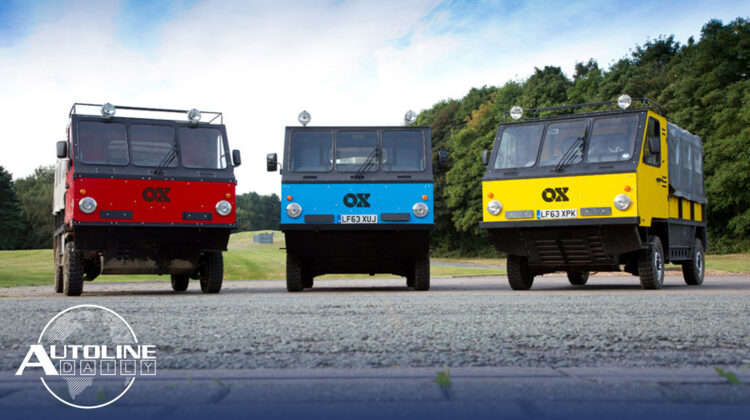
Follow us on social media:
Runtime: 6:23
0:07 Suspension Travel, To the Extreme!
0:57 Bosch Stops Motorcycles from Wiping Out
2:10 Low-Cost All-Terrain Vehicle
3:00 Shell’s Hyper Fuel-Efficient Semi-Truck
4:06 Semi Truck Lowrider
4:50 New Technique to Build Roads
Visit our sponsor to thank them for their support of Autoline Daily: Bridgestone.
This is Autoline Daily, reporting on the global automotive industry.
SUSPENSION TRAVEL, TO THE EXTREME!
In the past, making a military vehicle safer meant slapping on more armor. But the Defense Advanced Research Projects Agency or DARPA has a program that aims to improve survivability without adding more armor. Part of that initiative includes an extreme travel suspension system developed by Pratt & Miller. And when I say extreme, I mean extreme. It’s able to move 42-inches up and 30-inches down for a total of 6-feet of travel. This allows vehicles to travel at high rates of speed over rough terrain, without roughing the passengers up too much or drive on the side of a steep hill without fear of tipping over. And it’s pretty amazing how the cab of the vehicle barely seems to move.
BOSCH STOPS MOTORCYCLES FROM WIPING OUT
Advanced safety systems are common for cars, trucks and SUVs and now the supplier Bosch is working to bring the same technologies into motorcycles. It’s adding radar for bikes that allows for automatic cruise control, blind spot recognition, and collision warnings, where the rider gets an audio or visual signal if another vehicle is dangerously close. Bosch has also developed a solution that greatly reduces the risk of wiping out. If a sensor detects sideways wheel slip, a gas is vented through a nozzle that provides a lateral force to help keep the motorcycle upright and on course. Bosch says it’s like a magic hand that helps keep the bike upright and interestingly enough, the gas accumulator they use is plucked from passenger car airbags. And that should help keep down the cost.
LOW-COST ALL-TERRAIN VEHICLE
Three years ago, Gordon Murray Design, the British design house, along with the Global Vehicle Trust, introduced a low-cost, all-terrain vehicle called the OX. It was created for poor, rural areas in developing countries. It can carry a payload of 1,900 kilograms or about 4,190 pounds and can seat up to 13 people. It can be self-assembled and it uses fewer and more accessible parts to keep maintenance costs low. And now the oil company Shell, has commissioned a pre-production prototype of the OX, to bring it to India. It will test the vehicle with its fluids, including Shell Rimula, a diesel oil used to make engines run more efficiently in all-terrain conditions.
SHELL’S HYPER FUEL EFFICIENT SEMI-TRUCK
And speaking of Shell, it partnered with the Airflow Truck Company to develop a hyper fuel efficient Class 8 semi-truck, called the Starship. As you can see, the cab has been optimized for aerodynamics and is made out of carbon fiber. Other aero features include active grille shutters and an elongated boat tail at the rear. The truck is powered by a 15 liter, 6-cylinder diesel engine along with a 48V battery. It’s also equipped with a 5,000-watt solar array on top of the trailer. In its first test run of more than 2,300 miles across the U.S., the truck averaged nearly 9 MPG, which is about 2.5 MPG more than the average semi gets.
Autoline After Hours exclusive: Tadge Juechter, executive chief engineer on the Corvette C8. Join us as we take a deep dive into one of the most anticipated sports cars of the modern era. That’s Thursday, December 12 at 3 pm eastern time. Submit your questions to Tadge, send an email to: viewermail@autoline.tv
SEMI TRUCK LOWRIDER
Some truckers spend tens of thousands of dollars to deck out their rigs with lights, chrome and large painted murals. And it’s not just limited to the U.S. If you’ve never seen Japanese Dekotora, do a Google image search. And check out this Mercedes truck from Finland that was turned into a Lowrider. We love the bold purple paint with the graphics on the trailers and a huge mural of actor Danny Trejo on the cab. And of course, no lowrider would be complete without knock-off wire wheels, huge white-wall tires and a purple, white and gold velvet interior.
NEW TECHNIQUE TO BUILD ROADS
The assembly line is a staple of the automotive industry and now a Turkish company is applying the method to the way we produce roads. The company, Dahir Insaat, first applied a technique, called cast-in place construction in house building using a universal wall panel, but has adapted the thinking to road making. A giant, slow rolling machine handles most of the work. 13 large rolling pins, to tamp down the ground, sit at the front. A base layer of material, which is fed to the machine via trucks at the back, is then laid down. Next an entire row of cement puzzle-like blocks are laid over the base material. The blocks are loaded into the back of the machine and pieced together with a set of robot arms with suction cups on the end. This way, the machine is able to stay in constant motion and the process just repeats itself over and over. And once it gets far enough along, a final top coat is ready to be put over the top of the blocks. It really is a unique approach to road making and I don’t know about you, but it kind of reminds me of one of those giant launch platforms for space shuttles.
But that’s it for today, thanks for watching and please join us again tomorrow.
Thanks to our partner for embedding Autoline Daily on its website: WardsAuto.com

John McElroy is an influential thought leader in the automotive industry. He is a journalist, lecturer, commentator and entrepreneur. He created “Autoline Daily,” the first industry webcast of industry news and analysis.





